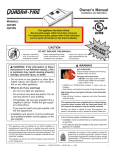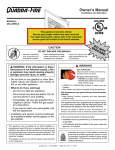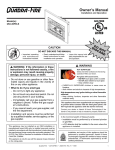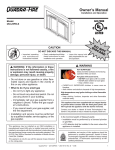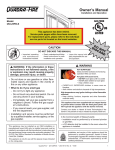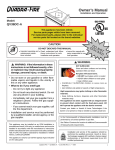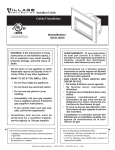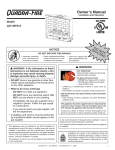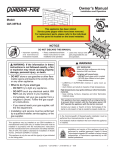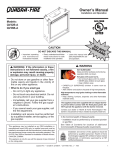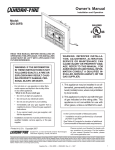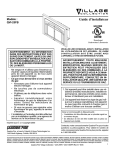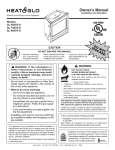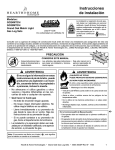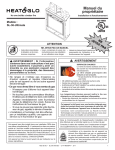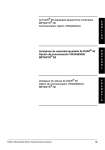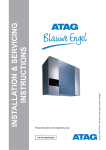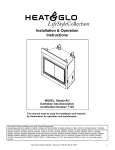Download Quadra-Fire QVI30S User's Manual
Transcript
Owner’s Manual R Installation and Operation Model(s): QVI30S QVI35S CAUTION DO NOT DISCARD THIS MANUAL • Important operating and maintenance instructions included. • Read, understand and follow these instructions for safe installation and operation. WARNING: If the information in these instructions is not followed exactly, a fire or explosion may result causing property damage, personal injury, or death. • Do not store or use gasoline or other flammable vapors and liquids in the vicinity of this or any other appliance. • What to do if you smell gas - Do not try to light any appliance - Do not touch any electrical switch. Do not use any phone in your building. - Immediately call your gas supplier from a neighbor’s phone. Follow the gas supplier’s instructions. - If you cannot reach your gas supplier, call the fire department. • Installation and service must be performed by a qualified installer, service agency, or the gas supplier. This appliance may be installed as an OEM installation in manufactured home (USA only) or mobile home and must be installed in accordance with the manufacturer’s instructions and the manufactured home construction and safety standard, Title 24 CFR, Part 3280 or Standard for Installation in Mobile Homes, CAN/CSA Z240MH. This appliance is only for use with the type(s) of gas indicated on the rating plate. • Leave this manual with party responsible for use and operation. D DI O N SC OT AR D WARNING HOT SURFACES! Glass and other surfaces are hot during operation AND cool down. Hot glass will cause burns. • DO NOT touch glass until it is cooled • NEVER allow children to touch glass • Keep children away • CAREFULLY SUPERVISE children in same room as fireplace. • Alert children and adults to hazards of high temperatures. High temperatures may ignite clothing or other flammable materials. • Keep clothing, furniture, draperies and other flammable materials away. This appliance has been supplied with an integral barrier to prevent direct contact with the fixed glass panel. DO NOT operate the appliance with the barrier removed. Contact your dealer or Hearth & Home Technologies if the barrier is not present or help is needed to properly install one. In the Commonwealth of Massachusetts: • installation must be performed by a licensed plumber or gas fitter; • a CO detector shall be installed in the room where the appliance is installed. Installation and service of this appliance should be performed by qualified personnel. Hearth & Home Technologies suggests NFI certified or factory trained professionals, or technicians supervised by an NFI certified professional. Quadra-Fire • QVI30S, QVI35S • 340-901 Rev. i • 6/09 1 Read this manual before installing or operating this appliance. Please retain this owner’s manual for future reference. Congratulations Congratulations on selecting a Quadra-Fire gas appliance —an elegant and clean alternative to wood burning appliances. The Quadra-Fire gas appliance you have selected is designed to provide the utmost in safety, reliability, and efficiency. This Owner’s Manual should be retained for future reference. We suggest that you keep it with your other important documents and product manuals. The information contained in this Owner’s Manual, unless noted otherwise, applies to all models and gas control systems. As the owner of a new appliance, you’ll want to read and carefully follow all of the instructions contained in this Owner’s Manual. Pay special attention to all Cautions and Warnings. Your new Quadra-Fire gas appliance will give you years of durable use and trouble-free enjoyment. Welcome to the Quadra-Fire family of appliance products! We recommend that you record the following pertinent information about your appliance. Homeowner Reference Information Model Name: ___________________________________________ Date purchased/installed: __________________ Serial Number:__________________________________________ Location on appliance: ____________________ Dealership purchased from: _______________________________ Dealer Phone: __________________________ Notes: _______________________________________________________________________________________ _____________________________________________________________________________________________ Listing Label Information/Location The model information regarding your specific appliance can be found on the rating plate usually located in the control area of the appliance. This product may be covered by one or more of the following patents: (Nos produits sont couverts par un ou plusieurs des brevets suivants): (United States) 4593510, 4686807, 4766876, 4793322, 4811534, 5000162, 5016609, 5076254, 5113843, 5191877, 5218953, 5263471, 5328356, 5341794, 5347983, 5429495, 5452708, 5542407, 5601073, 5613487, 5647340, 5688568, 5762062, 5775408, 5890485, 5931661, 5941237, 5947112, 5996575, 6006743, 6019099, 6048195, 6053165, 6145502, 6170481, 6237588, 6296474, 6374822, 6413079, 6439226, 6484712, 6543698, 6550687, 6601579, 6672860, 6688302B2, 6715724B2, 6729551, 6736133, 6748940, 6748942, D320652, D445174, D462436; (Canada)1297749, 2195264, 2225408; or other U.S. and foreign patents pending (ou autres brevets americains et etrangers en attente). R Type of Gas Quadra-Fire, a brand of Hearth & Home Technologies Inc. 1445 North Highway 395, Colville, WA 99114 Not for use with solid fuel. (Ne doit pas entre utilise avec un combustible solide). Type of Gas (Sorte De Gaz) Gaz): NATURAL TURAL GAS Gas and Electric Information This appliance must be installed in accordance with local codes, if any; if not, follow ANSI Z223.1 in the USA or CAN/CGA B149 installation codes. (Installer l’appareil selon les codes ou reglements locaux ou, en l’absence de tels reglements, selon les codes d’installation CAN/CGA-B149.) ANSI Z21XX-XXXX · CSA 2.XX-MXX · UL307B Minimum Permissible Gas Supply for Purposes of Input Adjustment. Approved Minimum (De Gaz) Acceptable 0.0 in w.c. (Po. Col. d’eau) Maximum Pressure (Pression) 0.0 in w.c. (Po. Col. d’eau) Maximum Manifold Pressure (Pression) 0.0 in w.c. (Po. Col. d’eau) Minimum Manifold Pressure (Pression) 0.0 in w.c. (Po. Col. d’eau) Total Electrical Requirements: 000Vac, 00Hz., less than 00 Amperes ALTITUDE: MAX. INPUT BTUH: MIN. INPUT BTUH: ORIFICE SIZE: 2 0-0000 FT. 00,000 00,000 #XXXXX IN CANADA 0000-0000FT. 00,000 00,000 #XXXXX MADE IN USA Model: (Modele): XXXXXXXX Serial (Serie): XXXXXXXX Quadra-Fire • QVI30S, QVI35S • 340-901 Rev. i • 6/09 Model Number Serial Number Table of Contents 1 Listing and Code Approvals A. B. C. D. E. F. 8 Gas Information Appliance Certification . . . . . . . . . . . . . . . . . . . . . . . . . . . . BTU Specifications . . . . . . . . . . . . . . . . . . . . . . . . . . . . . . . High Altitude Installations . . . . . . . . . . . . . . . . . . . . . . . . . . Non-Combustible Materials Specification. . . . . . . . . . . . . . Combustible Materials Specification . . . . . . . . . . . . . . . . . Electrical Codes . . . . . . . . . . . . . . . . . . . . . . . . . . . . . . . . . 4 4 4 4 4 4 A. Fuel Conversions . . . . . . . . . . . . . . . . . . . . . . . . . . . . . . . 14 B. Gas Pressures . . . . . . . . . . . . . . . . . . . . . . . . . . . . . . . . . 14 C. Gas Connection . . . . . . . . . . . . . . . . . . . . . . . . . . . . . . . . 14 9 Electrical Information A. Wiring the Appliance. . . . . . . . . . . . . . . . . . . . . . . . . . . . . 16 B. Junction Box Installation. . . . . . . . . . . . . . . . . . . . . . . . . . 17 2 Getting Started A. Design and Installation Considerations . . . . . . . . . . . . . . . 5 B. Tools and Supplies Needed . . . . . . . . . . . . . . . . . . . . . . . . 5 C. Inspect Appliance and Components . . . . . . . . . . . . . . . . . . 5 10 Finishing A. Mantel Projections . . . . . . . . . . . . . . . . . . . . . . . . . . . . . . 19 11 Appliance Setup 3 Fireplace Size Requirements A. Minimum Fireplace Opening . . . . . . . . . . . . . . . . . . . . . . . 6 B. Clearances . . . . . . . . . . . . . . . . . . . . . . . . . . . . . . . . . . . . . 7 4 Termination Locations A. Vent Termination Minimum Clearances . . . . . . . . . . . . . . . 8 5 Vent Information and Diagrams A. Vent Table Key . . . . . . . . . . . . . . . . . . . . . . . . . . . . . . . . . . 9 B. Horizontal Venting . . . . . . . . . . . . . . . . . . . . . . . . . . . . . . . 9 C. Measuring Standards . . . . . . . . . . . . . . . . . . . . . . . . . . . . . 9 6 Installation Preparation A. B. C. D. E. F. Flue Damper. . . . . . . . . . . . . . . . . . . . . . . . . . . . . . . . . . . Chimney . . . . . . . . . . . . . . . . . . . . . . . . . . . . . . . . . . . . . . Gas Line . . . . . . . . . . . . . . . . . . . . . . . . . . . . . . . . . . . . . . Hearth or Hearth Extension . . . . . . . . . . . . . . . . . . . . . . . Fireplace Conversion Notice . . . . . . . . . . . . . . . . . . . . . . Remote Control . . . . . . . . . . . . . . . . . . . . . . . . . . . . . . . . 10 10 10 10 10 10 A. B. C. D. E. F. G. H. Remove Shipping Materials . . . . . . . . . . . . . . . . . . . . . . . Clean the Appliance . . . . . . . . . . . . . . . . . . . . . . . . . . . . . Accessories . . . . . . . . . . . . . . . . . . . . . . . . . . . . . . . . . . . Ember Placement . . . . . . . . . . . . . . . . . . . . . . . . . . . . . . . Refractory Placement . . . . . . . . . . . . . . . . . . . . . . . . . . . Positioning the Logs . . . . . . . . . . . . . . . . . . . . . . . . . . . . Glass Assembly . . . . . . . . . . . . . . . . . . . . . . . . . . . . . . . . Air Shutter Setting . . . . . . . . . . . . . . . . . . . . . . . . . . . . . . 20 20 20Î 20 21 22 27 27 12 Operating Instructions A. B. C. D. E. Before Lighting Appliance. . . . . . . . . . . . . . . . . . . . . . . . . Lighting Appliance . . . . . . . . . . . . . . . . . . . . . . . . . . . . . . Check Pilot Flame Appearance . . . . . . . . . . . . . . . . . . . . After Appliance is Lit . . . . . . . . . . . . . . . . . . . . . . . . . . . . . Frequently Asked Questions . . . . . . . . . . . . . . . . . . . . . . 28 29 30 30 31 13 Troubleshooting A. Standing Pilot Ignition System . . . . . . . . . . . . . . . . . . . . . 32 14 Maintaining and Servicing Appliance 7 Installing Vent Pipe and Appliance A. B. C. D. A. Maintenance Tasks. . . . . . . . . . . . . . . . . . . . . . . . . . . . . . 34 Venting Components . . . . . . . . . . . . . . . . . . . . . . . . . . . . .11 Connecting Vent Pipe . . . . . . . . . . . . . . . . . . . . . . . . . . . . .11 Placing, Securing and Leveling the Appliance . . . . . . . . . 12 Installing Adaptor and Termination Cap . . . . . . . . . . . . . . 13 15 Reference Materials A. B. C. D. E. Appliance Dimension Diagram . . . . . . . . . . . . . . . . . . . . . Vent Kits Components . . . . . . . . . . . . . . . . . . . . . . . . . . . Service Parts . . . . . . . . . . . . . . . . . . . . . . . . . . . . . . . . . . Limited Lifetime Warranty . . . . . . . . . . . . . . . . . . . . . . . . . Contact Information . . . . . . . . . . . . . . . . . . . . . . . . . . . . . 36 37 38Î 43Î 45Î Î = Contains updated information. Quadra-Fire • QVI30S, QVI35S • 340-901 Rev. i • 6/09 3 1 Listing and Code Approvals C. High Altitude Installations A. Appliance Certification U.L. Listed gas appliances are tested and approved without requiring changes for elevations from 0 to 2000 feet in the U.S.A. and Canada. MODELS: QVI30S, QVI35S LABORATORY: Underwriters Laboratories, Inc. (UL) TYPE: Vented Gas Appliance Heaters STANDARD: ANSI Z21.88-2000 • CSA2.33-M00 • UL307B This product is listed to ANSI standards for “Vented Gas Appliance Heaters” and applicable sections of “Gas Burning Heating Appliances for Manufactured Homes and Recreational Vehicles”, and “Gas Fired Appliances for Use at High Altitudes”. NOT INTENDED FOR USE AS A PRIMARY HEAT SOURCE. This appliance is tested and approved as either supplemental room heat or as a decorative appliance. It should not be factored as primary heat in residential heating calculations. Note: To assure top performance, safety and efficiency, inserts must be installed with an approved flue liner as per CAN/CGA B-149 or National Fuel Gas Code ANSI Z223 and these instructions. Note: This installation must conform with local codes. In the absence of local codes you must comply with the National Fuel Gas Code, ANSI Z223.1-latest edition in the U.S.A. and the CAN/CGA B149 Installation Codes in Canada. B. BTU Specifications Minimum Input BTU/h Orifice Size (DMS) US (0-2000 FT) 32,000 22,000 #35 CANADA (2000-4500 FT) 28,800 19,800 #36 US (0-2000 FT) 35,500 23,500 #32 CANADA (2000-4500 FT) 31,950 21,150 #33 US (0-2000 FT) 31,000 18,000 #52 CANADA (2000-4500 FT) 27,900 16,200 #53 US (0-2000 FT) 31,000 19,000 #51 CANADA (2000-4500 FT) 27,900 17,100 #52 (U.S. or Canada) QVI30S (NG) QVI35S (NG) QVI30S (LP) QVI35S (LP) 4 If installing this appliance at an elevation above 4500 feet (in Canada), check with local authorities. WARNING Do NOT use this appliance if any part has been under water. Immediately call a qualified service technician to inspect the appliance and to replace any part of the control system and any gas control which has been under water. D. Non-Combustible Materials Specification Material which will not ignite and burn. Such materials are those consisting entirely of steel, iron, brick, tile, concrete, slate, glass or plasters, or any combination thereof. Materials that are reported as passing ASTM E 136, Standard Test Method for Behavior of Materials in a Vertical Tube Furnace at 750º C, shall be considered non-combustible materials. E. Combustible Materials Specification Maximum Input BTU/h Models When installing this appliance at an elevation above 2000 feet, it may be necessary to decrease the input rating by changing the existing burner orifice to a smaller size. Input rate should be reduced by 4% for each 1000 feet above a 2000 foot elevation in the U.S.A., or 10% for elevations between 2000 and 4500 feet in Canada. If the heating value of the gas has been reduced, these rules do not apply. To identify the proper orifice size, check with the local gas utility. Materials made of or surfaced with wood, compressed paper, plant fibers, plastics, or other material that can ignite and burn, whether flame proofed or not, or whether plastered or unplastered shall be considered combustible materials. F. Electrical Codes NOTICE: This appliance must be electrically wired and grounded in accordance with local codes or, in the absence of local codes, with National Electric Code ANSI/NFPA 70-latest edition or the Canadian Electric Code CSA C22.1. • A 110-120 VAC circuit for this product must be protected with ground-fault circuit-interrupter protection, in compliance with the applicable electrical codes, when it is installed in locations such as in bathrooms or near sinks. Quadra-Fire • QVI30S, QVI35S • 340-901 Rev. i • 6/09 2 Getting Started A. Design and Installation Considerations Quadra-Fire direct vent gas appliances are designed to operate with all combustion air siphoned from outside of the building and all exhaust gases expelled to the outside. No additional outside air source is required. CAUTION Check building codes prior to installation. • Installation MUST comply with local, regional, state and national codes and regulations. • Consult insurance carrier, local building, fire officials or authorities having jurisdiction about restrictions, installation inspection, and permits. Quadra-Fire gas inserts are designed for recessed installations into solid fuel masonry or factory built non-combustible fireplaces that have been installed in accordance with the National, Provincial, State and local building codes. Prior to installing the gas insert: • Have the chimney and adjacent structure inspected and cleaned by qualified professionals. Hearth & Home Technologies recommends that NFI or CSIA certified professionals, or technicians under the direction of certified professionals, conduct a minimum of a NFPA 211 Level 2 inspection of the chimney. • Replace component parts of the chimney and fireplace as specified by the professionals. • Ensure all joints are properly engaged and the chimney is properly secured. When planning an appliance installation, it’s necessary to determine the following information before installing: • Minimum fireplace size. See Section 3.A. • Gas supply piping. • Electrical wiring. • Finishing details. • Existing mantel, mantel legs and wall projection locations. See Section 3.C. • Whether optional accessories—devices such as a fan, wall switch, or remote control—are desired. B. Tools and Supplies Needed Before beginning the installation be sure that the following tools and building supplies are available. C. Inspect Appliance and Components WARNING Inspect appliance and components for damage. Damaged parts may impair safe operation. • Do NOT install damaged components. • Do NOT install incomplete components. • Do NOT install substitute components. Report damaged parts to dealer. • Carefully remove the appliance and components from the packaging. • The vent system components, surrounds and fronts are shipped in separate packages. • The fiber logs may be packaged separately and must be field installed. • Report to your dealer any parts damaged in shipment, particularly the condition of the glass. • Read all of the instructions before starting the installation. Follow these instructions carefully during the installation to ensure maximum safety and benefit. WARNING Hearth & Home Technologies disclaims any responsibility for, and the warranty will be voided by, the following actions: • Installation and use of any damaged appliance or vent system component. • Modification of the appliance or vent system. • Installation other than as instructed by Hearth & Home Technologies. • Improper positioning of the gas logs or the glass door. • Installation and/or use of any component part not approved by Hearth & Home Technologies. Any such action may cause a fire hazard. WARNING Keep appliance dry. • Mold or rust may cause odors. • Water may damage controls. Pliers Hi temp caulking material Hammer Flat blade screwdriver Voltmeter Framing square Gloves Variable speed drill 1/4 Hex drive Safety glasses Manometer Phillips screwdriver Tape measure Non-corrosive leak check solution 1/2 - 3/4 inch length, #6 or #8 Self-drilling screws Quadra-Fire • QVI30S, QVI35S • 340-901 Rev. i • 6/09 5 3 Fireplace Size Requirements • The metal floor of the solid fuel firebox may be removed to facilitate the installation of the insert. The appliance may not be placed directly on the base of the outer wrap, a 1/4 inch airspace must be provided between the insert and the floor of the outer wrap. Use the levelling legs to raise the insert a minimum of 1/4 inch. The original fireplace may never be returned to solid fuel in this condition. The sidewalls and top structure of the firebox may not be altered with the exception of removable baffles and dampers. A. Minimum Fireplace Opening Minimum fireplace opening requirements are shown in Figure 5.1. WARNING! Risk of Fire or Burns! Provide adequate clearance around air openings and for service access. Due to high temperatures, the appliance should be located out of traffic and away from furniture and draperies. • The firebrick (refractory), glass doors, screen rails, screen mesh and log grates can be removed from a factory built firebox in order to gain minimum gas insert opening requirements. • Cutting of any sheet metal parts of the fireplace in which the gas fireplace insert is to be installed is prohibited, except the floor as tested for and as noted above. • Any smoke shelves, shields and baffles may be removed from the factory built firebox if attached with mechanical fasteners. NOTE: For actual appliance dimensions refer to Section 15. B C TOP VIEW A Minimum Appliance Size Location QVI35S QVI30S Inches Millimeters Inches Millimeters A Front Width 33-1/4 845 29-1/4 743 B Rear Width 24-1/4 616 20-1/4 515 C Depth 13-5/8 346 13-5/8 346 * Height 22-3/4 578 20-1/4 515 * NOTE: If exhaust collar on insert and fireplace damper do not line up, add 4 inches (102mm) to minimum fireplace height for bends in vent pipe. Figure 3.1 Fireplace Opening 6 Quadra-Fire • QVI30S, QVI35S • 340-901 Rev. i • 6/09 B. Clearances WARNING Fire Risk. Odor Risk. • Clearance to combustible material under the insert is 1/4 inch (0.6 cm). • Use leveling legs to raise insert minimum 1/4 inch above combustible material or outer wrap of factory built firebox. WARNING Fire Risk. • Locate and install appliance to all clearance specifications in manual. EXHAUST VENT PIPE INLET AIR VENT PIPE 12 in. MAX. MANTEL 12 in. MIN. MEASUREMENTS FROM TOP EDGE OF UNIT Figure 3.2 Clearances to Mantels or other Combustibles above Appliance Quadra-Fire • QVI30S, QVI35S • 340-901 Rev. i • 6/09 7 4 Termination Locations A. Vent Termination Minimum Clearances Figure 4.1 specifies minimum vent heights for various pitched roofs. HORIZONTAL OVERHANG 2 FT. MIN. 20 INCHES MIN. VERTICAL WALL LOWEST DISCHARGE OPENING GAS DIRECT VENT TERMINATION CAP X 12 ROOF PITCH IS X/ 12 H (MIN.) - MINIMUM HEIGHT FROM ROOF TO LOWEST DISCHARGE OPENING Roof Pitch H (Min.) Ft. Flat to 6/12...........................................................1.0* Over 6/12 to 7/12 .................................................1.25* Over 7/12 to 8/12 .................................................1.5* Over 8/12 to 9/12 .................................................2.0* Over 9/12 to 10/12 ...............................................2.5* Over 10/12 to 11/12 .............................................3.25 Over 11/12 to 12/12 .............................................4.0 Over 12/12 to 14/12 .............................................5.0 Over 14/12 to 16/12 .............................................6.0 Over 16/12 to 18/12 .............................................7.0 Over 18/12 to 20/12 .............................................7.5 Over 20/12 to 21/12 .............................................8.0 * 3 foot minimum in snow regions Figure 4.1 Minimum height from roof to lowest discharge opening WARNING Fire Risk. Asphyxiation Risk. • Terminations MUST meet minimum clearances. • Exhaust gases are hot. • Nearby vents may draw fumes into house. 8 Quadra-Fire • QVI30S, QVI35S • 340-901 Rev. i • 6/09 5 Vent Information and Diagrams A. Vent Table Key WARNING The abbreviations listed in this vent table key are used in the vent diagrams. Symbol Description VMIN Minimum Vertical Run Length 14 ft. VMIN Maximum Vertical Run Length 50 ft. Fire Hazard. Explosion Risk. Asphyxiation Risk. Do NOT connect this gas appliance to a chimney flue serving a separate solid fuel or gas burning appliance. • May impair safe operation of this appliance or other appliances connected to the flue. • Vent this appliance directly outside. • Use separate vent system for this appliance. B. Horizontal Venting Horizontal venting is NOT allowed. C. Measuring Standards Vertical measurements listed in the vent diagram (Figure 5.1) were made using the following standard: • Vertical terminations are measured to top of chimney. CAUTION ALL vent specifications MUST be followed. • This product is tested and listed to these specifications. • Appliance performance will suffer if specifications are not followed. TERMINATION CAP ADAPTOR EXHAUST VENT PIPE INSULATION SEAL INLET VENT AIR PIPE Figure 5.1 Quadra-Fire • QVI30S, QVI35S • 340-901 Rev. i • 6/09 9 6 Installation Preparation Prepare the existing solid fuel masonry or factory built non-combustible firebox for installation. A. Flue Damper Fully lock the solid fuel fireplace’s flue damper in the open position, OR completely remove it. E. Fireplace Conversion Notice Permanently attach the label with the following warning to the inside lower back of the fireplace firebox into which the insert is being installed. Silicone may be required to properly secure the label. B. Chimney WARNING • Ensure chimney is constructed of non-combustible materials. • Ensure chimney is clean and in good working order. • Ensure that all chimney cleanouts fit properly to prevent air leakage into chimney. Fire Risk. This fireplace has been converted for use with a gas fireplace insert only and cannot be used for burning wood or solid fuels unless all original parts have been replaced, and the fireplace reapproved by the authority having jurisdiction. C. Gas Line • Check local codes and gas line sizing requirements following NFPA54. See Section 8. Prior to installing the gas insert: • Have the chimney and adjacent structure inspected and cleaned by qualified professionals. Hearth & Home Technologies recommends that NFI or CSIA certified professionals, or technicians under the direction of certified professionals, conduct a minimum of a NFPA 211 Level 2 inspection of the chimney. • Replace component parts of the chimney and fireplace as specified by the professionals. • Ensure all joints are properly engaged and the chimney is properly secured. D. Hearth or Hearth Extension F. Remote Control Note: If the factory built fireplace has no gas access hole provided, an access hole of 1 inch (25 mm) diameter or less may be drilled through the lower sides or bottom of the firebox in a proper workmanship - like manner. This access hole must be plugged with non-combustible insulation after the gas supply line has been installed. • Install gas line into firebox cavity. The receiver for the remotes must be installed BETWEEN the base pan of the insert and the firebox of the woodburning fireplace (see photo below). WARNING Fire Risk. A hearth or hearth extension (if present) must comply with either of the following: • The solid fuel burning fireplace manufacturer’s specification. • Local building codes required by authority having jurisdiction. • NFPA 211 EXISTING SIDE REFRACTORY REMOTE RECEIVER UNIT EXISTING BOTTOM OF FIREPLACE 10 Quadra-Fire • QVI30S, QVI35S • 340-901 Rev. i • 6/09 7 Installing Vent Pipe and Appliance A. Venting Components B. Connecting Vent Pipe Reference instructions in the termination kit. CAUTION • Install the 3-inch flexible vent pipe(s) down through the chimney. Sharp Edges • Wear protective gloves and safety glasses during installation. • Use three screws to secure the exhaust flexible vent pipe to the 3 foot section stainless steel flexible vent pipe using the factory-installed 3-inch collar in the stainless steel section of pipe (see Figure 7.1). The vertical vent termination system installed on this model includes: • One length of 3-inch flexible vent pipe for combustion air (included with vent kit). Pipe will be either a 4-foot or 30-foot section depending on which kit is being used in the application. • Flexible vent pipe for exhaust air (included with vent kit). • Use 3 screws to attach either a 4 foot or 30 foot section of inlet air vent to the inlet collar on the collar slide plate (see Figure 7.1). NOTE: The collar slide plate may be removed from appliance to aid installation. • Seal opening between flex vent and chimney just above insert. Non-combustible, unfaced fiberglass insulation may be used for this purpose. • One pipe-to-cap adaptor (included with vent kit). • One vertical termination cap (included with vent kit). TERMINATION CAP INLET AIR STARTING COLLAR EXHAUST AIR VENT PIPE LOCKING TAB STARTING COLLAR BRACKET EXHAUST STARTING COLLAR INLET AIR VENT PIPE INLET AIR STARTING COLLAR STARTING COLLAR BRACKET EXHAUST STARTING COLLAR Figure 7.1 Quadra-Fire • QVI30S, QVI35S • 340-901 Rev. i • 6/09 11 CUT AND BEND FLASHING AS NEEDED TO FIT CHIMNEY SEALANT ADHESIVE WARNING Fire Risk. Only an approved Hearth & Home Technologies surround may be used to cover integral grills on solid fuel burning fireplaces. • No other components such as shrouds, sheetmetal plates, etc., may be used to seal off vents. WARNING Failure to position the parts in accordance with these diagrams or failure to use only parts specifically approved with this appliance may result in property damage or personal injury. WARNING Figure 7.2 • Trim chimney top plate to minimize excess overhang or bend over flue tile (see Figure 7.2). • Place 3/8 inch bead of 300º F silicone on flue tile top. C. Placing, Securing and Leveling the Appliance • Install insert (without surround attached) into existing fireplace while pulling collar slide plate forward. Explosion Risk. Combustion Fume Risk. • Connect vent sections per installation instructions. • Connect exhaust vent pipe ONLY to exhaust starting collar and termination cap center collar. • Connect inlet air vent ONLY to inlet air collar on appliance and either the termination cap inlet air collar OR terminate within chimney. • Do NOT allow vent to sag below connection point to appliance. • Install gas line into hole provided on insert side. • If applicable install remote control wires into insert side (see Section 6, F.). • Secure collar slide plate to appliance by placing locking handle into position with locking tabs (see Figure 7.1) and secure with #8 screw. • Level the appliance from side to side and front to back. If necessary, use the leveling legs included with the manual bag to set each corner of the base. • Position any excess flexible vent pipe back up into chimney without sagging. Twist and push flex vent together to shorten. • Non-combustible, unfaced fiberglass insulation may be installed between the back of the decorative surround and the face of the existing fireplace surround to which the insert is being installed. This insulation is not required, but can assist in the prevention of infiltration of cold air and odors from the chimney. • Attach surround. Follow instructions accompanying surround. • Push insert so that surround becomes tight against face of fireplace. 12 Quadra-Fire • QVI30S, QVI35S • 340-901 Rev. i • 6/09 D. Installing Adaptor and Termination Cap CAUTION For installation of termination cap see minimum vent heights for various pitched roofs (see Figure 7.2) . Sharp Edges • Wear protective gloves and safety glasses during installation. To install adaptor see Figure 7.3. HORIZONTAL OVERHANG 2 FT. MIN. 20 INCHES MIN. Damper Flashing Kit (Optional) For use with LINK-DV4-30B Liner Kit. VERTICAL WALL Note: Damper may have to be removed to use this kit. LOWEST DISCHARGE OPENING • Run flex liners through 3” holes in damper flashing. GAS DIRECT VENT TERMINATION CAP • Attach damper flashing to firebox roof with self tapping screws included in kit. X 12 CLASS A PIPE ROOF PITCH IS X/ 12 H (MIN.) - MINIMUM HEIGHT FROM ROOF TO LOWEST DISCHARGE OPENING Roof Pitch H (Min.) Ft. Flat to 6/12....................1.0* Over 6/12 to 7/12 ........1.25* Over 7/12 to 8/12 ..........1.5* Over 8/12 to 9/12 ..........2.0* Over 9/12 to 10/12 ........2.5* Over 10/12 to 11/12 ..... 3.25 Roof Pitch H (Min.) Ft. Over 11/12 to 12/12 ....... 4.0 Over 12/12 to 14/12 ....... 5.0 Over 14/12 to 16/12 ....... 6.0 Over 16/12 to 18/12 ....... 7.0 Over 18/12 to 20/12 ....... 7.5 Over 20/12 to 21/12 ....... 8.0 * 3 foot minimum in snow regions Figure 7.2 Minimum Height from Roof to Lowest Discharge Opening Figure 7.3 To help eliminate cold air drafts, it may be necessary to place noncombustible insulation around the flues as they go though the damper. Masonry LINK-DV30B Installation Note: The LINK-DV4-30B system REQUIRES this insulation. Factory Built Wood Burning LINK-DV4-30B Installation OPTIONAL LINK-ZC-ADPB FOR USE WITH CLASS A WOODBURNING PIPE TERMINATION CAP EXHAUST AIR VENT PIPE ÍORÎ INLET AIR VENT PIPE Figure 7.4 WARNING: DO NOT BLOCK THIS PIPE END! Note: Untwist the pipe while extending it, to achieve full 30’ length. Remove 18 inch x 18 inch flashing on cap by removing 3 screws. Connect both the LINK-ZC-ADPB to Class A Pipe and the termination cap to the LINK-ZC-ADPB with the self tapping screws provided. Quadra-Fire • QVI30S, QVI35S • 340-901 Rev. i • 6/09 13 8 Gas Information A. Fuel Conversions C. Gas Connection Before making gas connections ensure that appliance being installed is compatible with the available gas type. Any natural or propane gas conversions necessary to meet the appliance and locality needs must be made by a qualified technician using Hearth & Home Technologies specified and approved parts. Note: Have the gas supply line installed in accordance with local building codes, if any. If not, follow ANSI 223.1. Installation should be done by a qualified installer approved and/or licensed as required by the locality. (In the Commonwealth of Massachusetts installation must be performed by a licensed plumber or gas fitter). B. Gas Pressures Proper input pressures are required for optimum appliance performance. Gas line sizing requirements need to be made following NFPA54. WARNING Fire Risk. Explosion Hazard. High pressure will damage valve. • Disconnect gas supply piping BEFORE pressure testing gas line at test pressures above 1/2 psig. • Close the manual shutoff valve BEFORE pressure testing gas line at test pressures equal to or less than 1/2 psig. Verify inlet pressures. • High pressure may cause overfire condition. • Low pressure may cause explosion. • Verify minimum pressures when other household gas appliances are operating. Install regulator upstream of valve if line pressure is greater than 1/2 psig. Pressure requirements for appliance are shown in the table below. Minimum pressures must be met when other household gas appliances are operating. Natural Gas Propane Minimum inlet pressure 5.0 inches w.c. 11.0 inches w.c. Maximum inlet gas pressure 14.0 inches w.c. 14.0 inches w.c. Manifold pressure 3.5 inches w.c. 10.0 inches w.c. 14 Refer to Reference Section 15 for location of gas line access in appliance. NOTE: Gas line may be run from either side of the appliance provided the hole in the outer wrap does NOT exceed 2-1/2 inches in diameter and does not penetrate the firebox. WARNING Gas Leak Risk • Support control when attaching pipe to prevent bending gas line. WARNING Pressure NOTE: A listed (and Commonwealth of Massachusetts approved) 1/2 inch (13 mm) T-handle manual shut-off valve and flexible gas connector are connected to the 1/2 inch (13 mm) control valve inlet. • If substituting for these components, please consult local codes for compliance. NOTE: The gap between supply piping and gas access hole may be caulked with high temperature caulk or stuffed with non-combustible, unfaced insulation to prevent cold air infiltration. • Ensure that gas line does not come in contact with outer wrap of appliance. Follow local codes. • Incoming gas line should be piped into the valve compartment and connected to the 1/2 inch connection on the manual shutoff valve. • Check all fittings and connections of appliance which may have loosened during shipping. Quadra-Fire • QVI30S, QVI35S • 340-901 Rev. i • 6/09 WARNING Fire or Explosion Hazard • • • • Gas buildup during line purge may ignite. Purge should be performed by qualified technician. Ensure adequate ventilation. Ensure there are no ignition sources such as sparks or open flames. • A small amount of air will be in the gas supply lines. When first lighting appliance it will take a short time for air to purge from lines. When purging is complete the appliance will light and operate normally. HIGH ALTITUDE INSTALLATIONS U.L. Listed gas appliances are tested and approved without requiring changes for elevations from 0 to 2000 feet in the U.S.A. and Canada. When installing this appliance at an elevation above 2000 feet, it may be necessary to decrease the input rating by changing the existing burner orifice to a smaller size. Input rate should be reduced by 4% for each 1000 feet above a 2000 foot elevation in the U.S.A., or 10% for elevations between 2000 and 4500 feet in Canada. If the heating value of the gas has been reduced, these rules do not apply. To identify the proper orifice size, check with the local gas utility. If installing this appliance at an elevation above 4500 feet (in Canada), check with local authorities. WARNING CHECK FOR GAS LEAKS Explosion Risk Fire Risk Asphyxiation Risk • Check all fittings and connections. • Do not use open flame. • After the gas line installation is complete, all connections must be tightened and checked for leaks with a commercially-available, non-corrosive leak check solution. Be sure to rinse off all leak check solution following testing. Fittings and connections may have loosened during shipping and handling. WARNING Fire hazard. Do NOT change the valve settings. • This valve has been preset at the factory. • Changing valve settings may result in fire hazard or bodily injury. Quadra-Fire • QVI30S, QVI35S • 340-901 Rev. i • 6/09 15 9 Electrical Information Appliance Requirements A. Wiring the Appliance Note: Electrical wiring must be installed by a licensed electrician. Note: This appliance must be electrically wired and grounded in accordance with local codes or, in the absence of local codes, with National Electric Code ANSI/NFPA 70-latest edition or the Canadian Electric Code, CSA C221.1. • This appliance DOES NOT require 110-120 VAC to operate. • It is recommended that a 110 VAC junction box be connected for use with fan or remote control. (See Figure 9.2 for junction box wiring). WARNING Wire 110V to electrical junction box. Do NOT wire 110V to valve. Do NOT wire 110V to wall switch. • Incorrect wiring will damage millivolt valves. • Incorrect wiring will override IPI safety lockout and may cause explosion. • A 110-120 VAC circuit for this product must be protected with ground-fault circuit-interrupter protection, in compliance with the applicable electrical codes, when it is installed in locations such as in bathrooms or near sinks. CAUTION ON/OFF Switch • Prevent accidental appliance operation when not attended. • Unplug or remove batteries from remote control if absent or if appliance will not be used for an extended period of time. • Property damage possible from elevated temperatures. • An ON/OFF switch is included with appliance and should attached to surround/facing. The location of the ON/OFF switch varies depending on model. It may be installed on the valve cover plate or included with the decorative surround. (See Installation instructions for remote control). • If desired an additional wall switch or thermostat may be added to system as shown in Figure 9.1). Follow directions included with the optional wall switch. STANDING PILOT REMOTE SWITCH PIGTAIL ON OFF VALVE ON/OFF SWITCH WHT OPTIONAL WALL SWITCH, THERMOSTAT OR REMOTE RED Figure 9.1 Standing Pilot Ignition Wiring Diagram 16 Quadra-Fire • QVI30S, QVI35S • 340-901 Rev. i • 6/09 B. Junction Box Installation JUNCTION BOX ACCESS SIDEWALL JUNCTION BOX SCREW PROVIDED Figure 9.2 Junction box installation Optional Accessories Connecting the electrical junction box is required if using a blower or remote. • Plug the cord into a convenient outlet. • An electrician may install an outlet box inside the fireplace. Place the outlet in the lower, back corner of the fireplace. • Must use cord supplied. CAUTION Label all wires prior to disconnection when servicing controls. Wiring errors can cause improper and dangerous operation. Verify proper operation after servicing. WARNING Shock hazard. • Replace damaged wire with type 105º C rated wire. • Wire must have high temperature insulation. Quadra-Fire • QVI30S, QVI35S • 340-901 Rev. i • 6/09 17 VARIABLE SPEED CONTROL JUNCTION BOX BLK BLK BLOWER RECEPTACLE BLK BLK BLK BLK BLK WHT BLK TEMPERATURE SENSOR SWITCH WHT GROUND BLOWER BLK GRN WHT 110-120 VAC FAN JUNCTION BOX NOTE: IF ANY OF THE ORIGINAL WIRE AS SUPPLIED WITH THE APPLIANCE MUST BE REPLACED, IT MUST BE REPLACED WITH TYPE 1050 C RATED WIRE. TEMPERATURE SENSOR SWITCH SPEED CONTROL (RHEOSTAT) BEND UP TABS GROUND WIRE (ATTACH TO ANY METAL SURFACE) Figure 9.4 Fan/Rheostat Wire Diagram 18 Quadra-Fire • QVI30S, QVI35S • 340-901 Rev. i • 6/09 10 Finishing A. Mantel Projections Figure 10.1 shows the minimum vertical and corresponding maximum horizontal dimensions of appliance mantels or other combustible projections above the top front edge of the appliance, not the surround. EXHAUST VENT PIPE INLET AIR VENT PIPE 12 in. MAX. MANTEL 12 in. MIN. MEASUREMENTS FROM TOP EDGE OF UNIT Figure 10.1 Clearances to Mantels or other Combustibles above Appliance Quadra-Fire • QVI30S, QVI35S • 340-901 Rev. i • 6/09 19 11 Appliance Setup A. Remove Shipping Materials Placing the Ember Material Remove shipping materials from inside or underneath the firebox. Ember material is shipped with this gas appliance. To place the ember material: B. Clean the Appliance • Embers CANNOT be placed directly over ports. Clean/vacuum any sawdust that may have accumulated inside the firebox or underneath in the control cavity. • When placing Glowing Embers® onto the burner care should be taken so that the ports are not covered. Place the dime-size ember pieces near port holes in burner top, sides and front (see Figure 11.1). Failure to follow this procedure will likely cause lighting and sooting problems. C. Accessories Install approved accessories per instructions included with Î accessories. Contact your dealer for a list of approved accessories. Refer to Section 16. WARNING Shock or fire risk. Use ONLY optional accessories approved for this appliance. • Using non-listed accessories voids warranty. • Using non-listed accessories may result in a safety hazard. • Only Hearth & Home Technologies approved accessories may be used safely. EMBER MATERIAL/BRAISES Figure 11.1 Placement of Embers D. Ember Placement WARNING Explosion Risk. • Follow ember placement instructions in manual. • Do NOT place embers directly over burner ports. • Replace ember material annually. • Place Mystic Ember over burner surface and around base of burner. Do not cover any burner port holes. Use this material to give the appliance a realistic ash bed. • Save the remaining ember materials for use during appliance servicing. The embers provided should be enough for 3 to 5 applications. Improperly placed embers interferes with proper burner operation. 20 Quadra-Fire • QVI30S, QVI35S • 340-901 Rev. i • 6/09 E. Refractory Placement Refractory Placement MODELS: Supreme-XT, Grand-XT, QVI30, QVI35, ADI60 CAUTION: Refractory is fragile! Carefully remove the refractory from the packaging. Note: Refractory patterns and colors vary and may be different from the ones represented in the instructions. Step 2: While holding the back wall in place, install the right side refractory. Bend down the small tab located on the top front edge of the firebox (see Figure 11.3). Step 1: Place the back wall refractory against the back wall of the unit. The cut-out will be over the pilot and air intake hole. On some models the refractory will be behind the pilot bracket (see Figure 11.2). Figure 11.3 Step 3: Install the left side refractory in the same manner (see Figure 11.4). Figure 11.2 Figure 11.4 340-945B 6/02 Quadra-Fire • QVI30S, QVI35S • 340-901 Rev. i • 6/09 21 Log Set Assembly: LOGS-QVI30 F. Positioning the Logs If the gas logs have been factory installed they should not need to be positioned. If the logs have been packaged separately, refer to the following instructions. CAUTION: Logs are fragile! Carefully remove the logs from the packaging. 1 6 4 3 2 PILOT BURNER 7 5 BASEPAN 1 1 Log #1 SRV340-701): Place log #1 in the back on the insert. Locate the legs of the log outside the 3/8” tabs to either side of the burner. Pull the log forward until the log is stopped by the back edge of the burner. The log should be centered. 340-935 2/02 22 Quadra-Fire • QVI30S, QVI35S • 340-901 Rev. i • 6/09 2 2 Log #2 (srv340-702): Position log #2 by locating its slot over the tab on the front left of the burner. The slot in the left end of the log slides into the vertical metal edge in front of the square cut out on the base pan. 3 3 Log #3 (srv340-703): Position log #3 by locating its slot over the tab on the front right of the burner. Push the right side back against the step in the base pan. 4 4 Log #4 (srv340-704): Place log #4 across log #1 and log #2 in the grooved out areas as shown. Quadra-Fire • QVI30S, QVI35S • 340-901 Rev. i • 6/09 23 5 5 Log #5 (srv340-706): Place log #5 across log #1 and log # 3. The notch in the bottom of the log sets on the carved out edge on top of log #3. The back of the log sits in the grooved out area in log #1. 6 6 Log #6 (srv340-705): Place log #6 across log #1 and log #5. The notch in the bottom of log #6 rests in the carved out section on top of log #5 and the left end of the log sits in the horizontal carved out section of log #1. 7 7 Log #7 (srv740-707): Small log #7 rests on the “ramp” on the backside of log #3. The burned out end of the log slopes down and to the left. 24 Quadra-Fire • QVI30S, QVI35S • 340-901 Rev. i • 6/09 Log Set Assembly: LOGS-QVI35 1 BURNER TAB TAB PILOT 4 5 BASEPAN 6 3 2 CAUTION: Logs are fragile! Carefully remove the logs from the packaging. 1 1 Log #1 (srv330-701): Place log #1 in the back on the insert. The log should fit tightly side to side and be against the back of the insert. 2 2 Log #2 (srv330-702): Position log #2 by locating its slot over the tab on the front left of the burner. The left end of log #2 is pushed up against the step in the base pan. Quadra-Fire • QVI30S, QVI35S • 340-901 Rev. i • 6/09 25 3 3 Log #3 (srv330-703): Position log #3 by locating its slot over the tab on the right front of the burner. The right end of log #3 is pushed up against the step in the base pan. 4 4 Log #4 (srv340-705): Rest log #4 in the left smooth cut-out area on the end of log #1 and place the lower end on log #2. The left end and “bump” of log #4 both rest on log #2. 5 5 Log #5 (srv330-704): Rest log #5 in the second smooth cut-out area on the end of log #1 and place the lower end on log #2. The “Y” end of the log sits on the right end of log #2. 26 Quadra-Fire • QVI30S, QVI35S • 340-901 Rev. i • 6/09 6 6 Log #6 (SRV330-706): Nest log #6 in the cut out area on the right side of log #1. The thinnest “arm” of log #6 rests on top of log #3. G. Glass Assembly Replacing Glass Assembly WARNING Handle glass doors with care. • Inspect the gasket to ensure it is undamaged. • Inspect the glass for cracks, chips or scratches. • Do NOT strike, slam or scratch glass. • Do NOT operate appliance with glass door removed, cracked, broken or scratched. • Replace glass door assembly as a complete appliance. QVI30S Tilt glass assembly toward fireplace and slide glass assembly up to engage top two tabs with the corresponding slots. Fasten the two bottom latches. QVI35S Tilt glass assembly toward fireplace and slide glass assembly upward to engage top latches. Verify top latches are fully engaged and then fasten the two bottom latches. Removing Glass Assembly The glass assembly fastens to the fireplace in four places. Two or four of the fastening mechanisms will be springloaded glass latches, depending on the model. An example of the glass latch is shown in Figure 11.5. GLASS ASSEMBLY QVI30S BOTTOM LATCH To release glass assembly, pull the two bottom springloaded latches forward and allow them to retract away from the glass assembly. Remove glass assembly by carefully pulling the bottom side of the glass assembly out first. Carefully slide the glass assembly outward and downward until the top tabs are disengaged from the slots. QVI35S To release glass assembly, pull the two bottom springloaded latches forward and allow them to retract away from the glass assembly. Slide the glass assembly outward and downward until the top latches disengage. Figure 11.5 Glass Assembly H. Air Shutter Setting Optimal flame appearance is dependent on the air shutter setting. Adjustments should be made by a qualified technician. Model NG LP QVI35S 1/2 in. Full Open (3/4 in.) QVI30S 3/8 in. Full Open (3/4 in.) Quadra-Fire • QVI30S, QVI35S • 340-901 Rev. i • 6/09 27 12 Operating Instructions A. Before Lighting Appliance WARNING This appliance has a Standing Pilot Ignition. HOT SURFACES! Glass and other surfaces are hot during operation AND cool down. Before operating this appliance have a qualified technician: • Remove all shipping materials from inside and/or underneath the firebox. • Review proper placement of logs, rockwool, lava rock, and vermiculite. • Check the wiring. • Check the air shutter adjustment. • Purge gas line (with glass assembly removed). See Section 8. • Ensure that there are no gas leaks. • Ensure that the glass is sealed and in the proper position. • Ensure that the flow of combustion and ventilation air is not obstructed (front grilles and vent caps). Hot glass will cause burns. • DO NOT touch glass until it is cooled • NEVER allow children to touch glass • Keep children away • CAREFULLY SUPERVISE children in same room as fireplace. • Alert children and adults to hazards of high temperatures. High temperatures may ignite clothing or other flammable materials. • Keep clothing, furniture, draperies and other flammable materials away. This appliance has been supplied with an integral barrier to prevent direct contact with the fixed glass panel. DO NOT operate the appliance with the barrier removed. Contact your dealer or Hearth & Home Technologies if the barrier is not present or help is needed to properly install one. WARNING Fire Risk. Explosion Risk. Gas may build up while lighting pilot. • Remove glass assembly before lighting pilot. • Replace glass assembly after lighting pilot. WARNING Improper installation, adjustment, alteration, service or maintenance can cause injury or property damage. Refer to the owner’s information manual provided with this appliance. For assistance or additional information consult a qualified installer, service agency or the gas supplier. WARNING Do NOT use this appliance if any part has been under water. Immediately call a qualified service technician to inspect the appliance and to replace any part of the control system and any gas control which has been under water. 28 Quadra-Fire • QVI30S, QVI35S • 340-901 Rev. i • 6/09 B. Lighting Appliance Standing Pilot Ignition LIGHTING INSTRUCTIONS FOR YOUR SAFETY READ BEFORE LIGHTING 1. Turn off all electric power to the appliance. WARNING: If you do not follow these instructions exactly, a fire or explosion may result causing property damage, personal injury or loss of life. A. This appliance has a pilot which must be lighted by hand. When lighting the pilot, follow these instructions exactly. B. BEFORE LIGHTING, smell all around the appliance area for gas. Be sure to smell next to the floor because some gas is heavier than air and will settle on the floor. WHAT TO DO IF YOU SMELL GAS • Do not try to light any appliance. • Do not touch any electric switch; do not use any phone in your building. • Immediately call your gas supplier from a neighbor’s phone. Follow the gas supplier’s instructions. • If you cannot reach your gas supplier, call the fire department. C. Use only your hand to push in or turn the gas control knob. Never use tools. If the knob will not push in or turn by hand, don’t try to repair it, call a qualified service technician. Force or attempted repair may result in a fire or explosion. D. Do not use this appliance if any part has been under water. Immediately call a qualified service technician to inspect the appliance and to replace any part of the control system and any gas control which has been under water. WARNING: CAUTION: DO NOT CONNECT 110 VAC TO THE CONTROL VALVE. Hot while in operation. Do not touch. Keep children, clothing, furniture, gasoline and other liquids having flammable vapors away. Improper installation, adjustment, alteration, service or maintenance can cause injury or property damage. Refer to the owner’s information manual provided with this appliance. This appliance needs fresh air for safe operation and must be installed so there are provisions for adequate combustion and ventilation air. If not installed, operated, and maintained in accordance with the manufacturer’s instructions, this product could expose you to substances in fuel or fuel combustion which are known to the State of California to cause cancer, birth defects, or other reproductive harm. Keep burner and control compartment clean. See installation and operating instructions accompanying appliance. Do not operate the appliance with panel(s) removed, cracked or broken. Replacement of the panel(s) should be done by a licensed or qualified service person. NOT FOR USE WITH SOLID FUEL 2. Push in gas control knob slightly and turn clockwise to “OFF”. NOTE: Knob cannot be turned from “PILOT” to “OFF” unless knob is pushed in slightly. Do not force. 3. Wait five (5) minutes to clear out any gas. Then smell for gas, including near the floor. If you smell gas, STOP! Follow “B” in the Safety Information located on the left side of this label. If you don’t smell gas, go to next step. 4. Find the pilot. The pilot is inside combustion chamber next to the main burner. 5. Turn knob on gas control counter clockwise to “PILOT”. 6. Push in control knob all the way and hold in. Immediately depress red or black piezo button. It may require several depressions of the red or black piezo button until PILOT lights. If PILOT light does not light after 10 seconds, return to step 3. Continue to hold the control knob in for about one minute after the pilot is lit. Release knob and it will pop back out. Pilot should remain lit. If it goes out, repeat steps 3 through 6. • If knob does not pop up when released, stop and immediately call your service technician or gas supplier. • If the pilot will not stay lit after several tries, turn the gas control knob to “OFF” and call your service technician or gas supplier. 7. Turn gas control knob counterclockwise to “ON”. 8. To light Burner, flip the on/off switch to the “ON” position, and close access grille. 9. Turn on all electric power to the appliance. For use with natural gas and propane. A conversion kit, as supplied by the manufacturer, shall be used to convert this appliance to the alternate fuel. Also Certified for Installation in a Bedroom or a Bedsitting Room. For assistance or additional information, consult a qualified installer, service agency or the gas supplier. For additional information on operating your Hearth & Home Technologies fireplace, please refer to www.fireplaces.com. TO TURN OFF GAS TO APPLIANCE 1. Turn off all electric power to the appliance if service is to be performed. 2. Open control access panel. 3. Move switch to “OFF” position. 4. Push in gas control knob slightly and turn clockwise to OFF”. Do not force. 5. Quadra-Fire • QVI30S, QVI35S • 340-901 Rev. i • 6/09 Close control access panel. 464-903G 29 C. Check Pilot Flame Appearance D. After Appliance is Lit Pilot flame must contact the thermocouple and thermopile for reliable appliance operation. • Pilot flame should be as shown in Figure 12.1. WARNING Glass door must be in place when appliance is operating. Risk of: • Combustion Fumes • Fire Do NOT operate appliance with glass door removed. • Open viewing glass for servicing only. • Glass door MUST be in place and sealed before operating appliance. • Only use glass door certified for use with appliance. • Glass replacement should be done by qualified technician. Initial Break-in Procedure When you light the appliance, you may notice that it produces heat which does have an associated odor or smell. If you feel this odor is excessive it may require the initial three to four hour continuous burn on high followed by a second burn up to 12 hours to fully drive off any odor from paint and lubricants used in the manufacturing process. Condensation of the glass is normal. Figure 12.1 Proper Pilot Flame • If adjustment is needed remove cap screw from gas valve using 1/8 inch standard screwdriver (see Figure 12.2). • Turn adjustment screw clockwise to increase pilot flame size. Make small adjustments. PILOT ADJUSTMENT Note: The appliance should be run three to four hours on the initial start-up. Turn it off and let it cool completely. Remove and clean the glass. Replace the glass and run the appliance for an additional 12 hours. This will help to cure the products used in the paint and logs. During this break-in period it is recommended that some windows in the house be opened for air circulation. This will help avoid setting off smoke detectors, and help eliminate any odors associated with the appliance’s initial burning. Figure 12.2 Adjustments • Do NOT turn adjustment screw counter-clockwise too far as it will come out of the valve allowing gas to escape. • Replace cap screw and seal to prevent gas leaks. • Check for gas leaks after tightening. 30 Quadra-Fire • QVI30S, QVI35S • 340-901 Rev. i • 6/09 CAUTION WARNING Fire Risk. High Temperatures. Keep combustible household items away from appliance. Do NOT obstruct combustion and ventilation air. • Do NOT place combustible items on top of or in front of appliance. • Keep furniture, draperies away from appliance. CAUTION • Prevent accidental appliance operation when not attended. • Unplug or remove batteries from remote control if absent or if appliance will not be used for an extended period of time. • Property damage possible from elevated temperatures. Smoke and odors released during initial operation. • Open windows for air circulation. • Leave room during initial operation. • Smoke may set off smoke detectors. Smoke and odors may be irritating to sensitive individuals. WARNING Fire Hazard. Keep combustible materials, gasoline and other flammable vapors and liquids clear of appliance. • Do NOT store flammable materials in the appliance’s vicinity. • Do NOT use gasoline, lantern fuel, kerosene, charcoal lighter fluid or similar liquids in this appliance. • Combustible materials may ignite. E. Frequently Asked Questions ISSUE SOLUTIONS Condensation on the glass This is a result of gas combustion and temperature variations. As the appliance warms, this condensation will disappear. Blue flames This is a result of normal operation and the flames will begin to yellow as the appliance is allowed to burn for 20 to 40 minutes. Odor from appliance When first operated, this appliance may release an odor for the first several hours. This is caused by the curing of the paint and the burning off of any oils remaining from manufacturing and might set off home smoke detectors. Film on the glass Metallic noise This is a normal result of the curing process of the paint and logs. Glass should be cleaned within 3 to 4 hours of initial burning to remove deposits left by oils from the manufacturing process. A non-abrasive cleaner such as gas fireplace glass cleaner may be necessary. See your dealer. Noise is caused by metal expanding and contracting as it heats up and cools down, similar to the sound produced by a furnace or heating duct. This noise does not affect the operation or longevity of the appliance. Is it normal to see the pilot flame burn In a standing pilot system the pilot will always stay on. continually? Quadra-Fire • QVI30S, QVI35S • 340-901 Rev. i • 6/09 31 13 Troubleshooting With proper installation, operation, and maintenance your gas appliance will provide years of trouble-free service. If you do experience a problem, this troubleshooting guide will assist a qualified service person in the diagnosis of a problem and the corrective action to be taken. This troubleshooting guide can only be used by a qualified service technician. A. Standing Pilot Ignition System Symptom Possible Causes Corrective Action 1. After repeated triggering a. Defective ignitor. of the red or black piezo ignitor button, the spark ignitor will not light the pilot. b. Defective pilot or misaligned electrode (spark at electrode). Check the spark at the electrode and pilot. If no spark and electrode wire is properly connected, replace the ignitor. c. No gas or low gas pressure. Check the remote shut-off valves from the fireplace. Usually, there is a valve near the gas main. There can be more than one (1) valve between the fireplace and the main. d. No LP in tank. Check the LP (propane) tank. You may be out of fuel. a. Defective thermocouple. Check that the pilot flame impinges on the thermocouple. Clean and/or adjust the pilot for maximum flame impingement. 2. The pilot will not stay lit after carefully following the lighting instructions. Using match, light the pilot. If the pilot lights, turn off the pilot and trigger the red piezo ignitor button again. If the pilot lights, an improper gas/air mixture caused the bad lighting and a longer purge period is recommended. If the pilot will not light, ensure the gap at the electrode and pilot is one-eighth (1/8) inch to have a strong spark. If the gap is OK, replace the pilot. Ensure that the thermocouple connection at the gas valve is fully inserted and tight (hand tighten plus 1/4 turn). Disconnect the thermocouple from the valve, place one millivolt meter lead wire on the tip of the thermcouple and the other meter lead wire on the thermocouple copper lead. Start the pilot and hold the valve knob in. If the millivolt reading is less than 15mV, replace the thermocouple. b. Defective valve. 3. The pilot is burning, a. ON/OFF switch or wires there is no burner flame, defective. the valve knob is in the ON position, and the ON/OFF switch is in the ON position. If the thermocouple is producing more than 15 millivolts, replace faulty valve. Check the ON/OFF switch and wires for proper connections. Place the jumper wires across the terminals at the switch. If the burner comes on, replace the defective switch. If the switch is OK, place the jumper wires across the switch wires at the gas valve. If the burner comes on, the wires are faulty or connections are bad. b. Thermopile may not be gener- If the pilot flame is not close enough physically to the thermopile, ating sufficient millivoltage. adjust the pilot flame. Be sure the wire connections from the thermopile at the gas valve terminals are tight and that the thermopile is fully inserted into the pilot bracket. Check the thermopile with a millivolt meter. Take the reading at TH-TP&TP terminals of the gas valve. The meter should read 325 millivolts minimum, while holding the valve knob depressed in the pilot position, with the pilot lit, and the ON/OFF switch in the OFF position. Replace the faulty thermopile if the reading is below the specified minimum. With the pilot in the ON position, disconnect the thermopile leads from the valve. Take a reading at the thermopile leads. The reading should be 325 millivolts minimum. Replace the thermopile if the reading is below the minimum. 32 Quadra-Fire • QVI30S, QVI35S • 340-901 Rev. i • 6/09 Troubleshooting (continued) Symptom 3. Continued Possible Cause Corrective Action c. Defective valve. Turn the valve knob to the ON position. Place the ON/OFF switch in the ON position. Check the millivolt meter a the thermopile terminals. The millivolt meter should read greater than 125mV. If the reading is acceptable, and if the burner does not come on, replace the gas valve. d. Plugged burner orifice. Check the burner orifice for stoppage. Remove stoppage. e. Wall switch or wires are defective. Follow the corrective action in Symptom and Possible Cause 1.a above. Check the switch and wiring. Replace where defective. 4. Frequent pilot outage a. Pilot flame may be too high or too low, or blowClean thermocouple and adjust the pilot flame for problem. ing out (high pressure), causing pilot safety to drop maximum flame impingement. Follow lighting instrucout. tions carefully. 5. The pilot and main burner extinguish while in operation. 6. Glass soots. 7. Flame burns blue and lifts off burner. a. No LP in tank. Check the LP (propane) tank. Refill the fuel tank. b. Inner vent pipe leaking exhaust gases back into Check venting system for damage. Replace/repair the system. improperly assembled pipe sections. c. Glass too loose and air tight packet leaks in corners after usage. Replace glass panel assembly. d. Bad thermopile or thermocouple. Replace if necessary. e. Improper vent cap installation. Check for proper installation and freedom from debris or blockage. a. Flame impingement. Adjust the log set so that the flame does not excessively impinge on it. b. Improper air shutter setting. Adjust the air shutter located on the control panel. c. Debris around air shutter. Inspect the opening at the base of the burner. NO MATERIAL SHOULD BE PLACED IN THIS OPENING. a. Insufficient oxygen being supplied. Ensure that the vent cap is installed properly and free of debris. Ensure that the vent system joints are tight and have no leaks. Ensure that no debris has been placed at the base of, or in the area of the air holes in the center of the base pan beneath the burner. Ensure that the glass is tightened properly on the unit, particularly on top corners. Quadra-Fire • QVI30S, QVI35S • 340-901 Rev. i • 6/09 33 14 Maintaining and Servicing Appliance A. Maintenance Tasks Although the frequency of appliance servicing and maintenance will depend on use and the type of installation, a qualified service technician should perform an appliance checkup at the beginning of each heating season. CAUTION WARNING Risk of injury or property damage. Before servicing: • Turn off gas. • Turn off electricity to appliance. • Disable remote control, if one is present. • Ensure appliance is completely cooled. After servicing: • Replace any screen or barrier that was removed. • Reseal and reinstall any venting removed for servicing. WARNING Annual inspection by qualified technician recommended. Check: • Condition of doors, surrounds and fronts. • Condition of glass, glass assembly and glass seal. • Obstructions of combustion and ventilation air. • Condition of logs. • Condition of firebox. • Burner ignition and operation. • Burner air shutter adjustment • Gas connections and fittings. • Obstructions of termination cap. Handle glass assembly with care. NOTE: Clean glass after initial 3-4 hours operation. Longer operation without cleaning glass may cause a permanent white film on glass. When cleaning glass door: • Avoid striking, scratching or slamming glass. • Do NOT use abrasive cleaners. • Use a hard water deposit glass cleaner on white film. • Do NOT clean glass when hot. • Turn off appliance after 3-4 hours of operation and ALLOW TO COOL. • Remove and clean glass assembly. • Replace glass assembly and operate appliance for additional 12 hours. Refer to maintenance instructions. WARNING Inspect external vent cap regularly. • Ensure no debris blocks cap. • Combustible materials blocking cap may ignite. • Restricted air flow affects burner operation. Clean: • Glass • Air passageways, grilles, control compartment • Burner, burner ports Risk of: • Fire • Delayed ignition or explosion • Exposure to combustion fumes • Odors 34 Quadra-Fire • QVI30S, QVI35S • 340-901 Rev. i • 6/09 Inspect Doors, Surrounds and Fronts Maintenance Tasks 1. Assess condition of screen and replace as necessary. Recommend addition of screen if one is not present. 2. Inspect for scratches, dents or other damage and repair as necessary. 3. Verify no obstructions to airflow through the louvers. 4. Verify maintenance of proper clearance to combustible household objects. Gasket Seal, Glass Assembly and Glass 1. Inspect gasket seal and its condition. 2. Inspect glass panels for scratches and nicks that can lead to breakage when exposed to heat. 3. Confirm there is no damage to glass or glass frame. Replace as necessary. 4. Verify that latches engage properly, clip studs are not stripped, and glass attachment components are intact and operating properly. Replace as necessary. 5. Clean glass. Replace glass assembly if severely coated with silicate deposits that cannot be removed. Valve Compartment and Firebox Top 1. Vacuum and wipe out dust, cobwebs, debris or pet hair. Use caution when cleaning these areas. Screw tips that have penetrated the sheet metal are sharp and should be avoided. 2. Remove any foreign objects. 3. Verify unobstructed air circulation. Logs 1. Inspect for broken, damaged, or missing logs. Replace as necessary. 2. Verify correct log placement and no flame impingement causing sooting. Correct as necessary. Firebox 1. Inspect for paint condition, warpage, corrosion or perforation. Sand and repaint as necessary. 2. Replace appliance if firebox has been perforated. Burner Ignition and Operation 1. Verify burner is properly secured and aligned with pilot or igniter. 2. Clean off burner top, inspect for plugged ports, corrosion or deterioration. Replace burner if necessary. 3. Replace ember materials with new dime-size and shape pieces. Do not block ports or obstruct lighting paths. 4. Check for smooth lighting and ignition carryover to all ports. Verify there is no ignition delay. 5. Inspect for lifting or other flame problems. 6. Verify air shutter is clear of dust and debris. 7. Inspect orifice for soot, dirt or corrosion. 8. Verify manifold and inlet pressures. Adjust regulator as required. 9. Inspect pilot flame strength. Clean or replace orifice as necessary. 10. Inspect thermocouple/thermopile for soot, corrosion and deterioration. Clean with emery cloth or replace as required. 11. Verify millivolt output. Replace as necessary. Venting 1. Inspect venting for blockage or obstruction such as bird nests, leaves, etc. 2. Confirm that termination cap remains clear and unobstructed by plants, etc. 3. Verify that termination cap clearance to subsequent construction (building additions, decks, fences or sheds) has been maintained. 4. Inspect for corrosion or separation. 5. Verify weather stripping, sealing and flashing remains intact. 6. Inspect draft shield to verify it is not bent, damaged or missing. Remote controls 1. Verify operation of remote. 2. Replace batteries in remote transmitters and battery-powered receivers. 3. Verify batteries have been removed from battery back-up IPI systems to prevent premature battery failure or leaking. Quadra-Fire • QVI30S, QVI35S • 340-901 Rev. i • 6/09 35 15 Reference Materials A. Appliance Dimension Diagram Dimensions are actual appliance dimensions. Use for reference only. For framing dimensions and clearances refer to Section 3. A B C L M N K O J D E I F G H ELECTRICAL ACCESS GAS INLET T P Q U R S MODEL DIMENSIONS MODEL DIMENSIONS QVI35S QVI30S QVI35S LOCATION Inches Millimeters Inches Millimeters Inches Millimeters Inches A 33-1/32 839 29-1/32 737 K 2-5/16 58 2-5/16 58 B 24-1/4 616 20-5/32 512 L 4-7/16 112 4-7/16 112 C 12-1/8 308 10-3/32 256 M 5-5/32 131 5-5/32 131 D 36-7/8 937 32-5/16 821 N 2-5/32 55 2-5/32 55 E 32 813 27-25/32 706 O 13-23/32 348 13-23/32 348 F 14-3/4 375 12-7/16 316 P 2-17/32 64 2-17/32 64 G 27 686 22-23/32 577 Q 5-9/32 135 5-9/32 135 H 22-3/4 578 20-1/4 514 R 8-29/32 227 8-29/32 227 I 23-11/16 602 21-5/32 537 S 14-11/16 373 14-11/16 373 J 8-7/16 REF 215 8-7/16 REF 215 T 2-19/32 66 2-19/32 66 U 6-1/16 154 6-1/16 154 Figure 15.1 Appliance Dimensions 36 QVI30S LOCATION Quadra-Fire • QVI30S, QVI35S • 340-901 Rev. i • 6/09 Millimeters B. Vent Kits Components Direct Vent Flex Liner Kits (see Figure 15.2) LINK-DV30B: Masonry 3 inch flex liner kit. Sections expand to 30 feet. Includes: two liners, termination cap, flashing, and link adapter. LINK-DV4-30B: Masonry 3 inch flex liner kit. Sections expand to 30 feet and 4 feet. Includes: two liners, termination cap, flashing, and link adapter. LINK-DV30B Installation FLASH-DAMP LINK-DV4-30B Installation TERMINATION CAP EXHAUST AIR VENT PIPE LINK-ZC-ADP WARNING: DO NOT BLOCK THIS PIPE END! INLET AIR VENT PIPE SVRLINK-ADP OPTIONAL LINK-ZC-ADPB FOR USE WITH CLASS A WOODBURNING PIPE FLEX3-30 Figure 15.2 Direct Vent Flex Liner Kits Direct Vent Flex Liner Accessory Kits (see Figure 15.3) FLEX3-30/2 Flash-Damp: Zero clearance damper flashing kit for use with LINK-DV30B or LINK-DV4-30B liner kits. LINK-ZC-ADP: Zero clearance chimney adapter SVRLINK-ADP: Adapter kit (colinear to coaxial 3 inches included in above kits). FLEX3-30: One 3 inch flexible liner expands to 30 feet. FLEX3-30/2: Two 3 inch flexible liners expands to 30 feet each. FLEX-CNCT: Connector kit - 3 inch liner to 3 inch liner, one connector per kit. FLEX3-CNCT Figure 15.3 Direct Vent Flex Liner Accessory Kits Quadra-Fire • QVI30S, QVI35S • 340-901 Rev. i • 6/09 37 QVI30S R C. Service Parts Beginning Manufacturing Date: Aug. 2007 Ending Manufacturing Date: ______ Service Parts Diagram 8 9 10 20 11 12 15 14 13 18 19 17 16 Log Set Assembly 4 6 2 Part number list on following page. 38 Quadra-Fire • QVI30S, QVI35S • 340-901 Rev. i • 6/09 1 5 7 3 QVI30S R Service Parts Service Parts Diagram IMPORTANT: THIS IS DATED INFORMATION. When requesting service or replacement parts for your appliance please provide model number and serial number. All parts listed in this manual may be ordered from an authorized dealer. ITEM DESCRIPTION COMMENTS Stocked at Depot PART NUMBER Log Set Assembly LOGS-QVI30 1 Log 1 SRV340-701 2 Log 2 SRV340-702 3 Log 3 SRV340-703 4 Log 4 SRV340-704 5 Log 5 SRV340-706 6 Log 6 SRV340-705 7 Log 7 SRV740-707 8 Fireplace Termination Assembly 319-213A 9 Refractory Kit BRICK-QVI30 10 Burner 11 Andirons 12 Control Panel 349-176A Pre Nov 2008 80784 Post Nov 2008 2014-300 Y Y 319-129 13 Flame Control Knob 571-533 Y 14 Piezo Ignitor 291-513 Y 15 Glass Door Assembly GLA-349 Y 16 Rheostat Knob 100-512 Y 17 Pilot Control Knob 571-534 Y 18 On/Off Rheostat 319-510A Y 19 Blower GFK-160A 20 Junction Box 040-250A Base Refractory 349-124 Flex Pipe Handle 438-351 Glass Latch Assembly 386-122A Lava Rock 705-420 Left Panel Extension 340-265 Mineral Wool 050-721 Orifice NG (#35C) 582-835 Y Orifice LP (#52C) 582-852 Y Y Y Y Pilot Tube SRV485-301 Right Panel Extension 340-266 Thermocouple 2103-511 Y Thermopile 2103-512 Y Touch Up Paint TUP-GBK-12 Conversion Kit NG NGKS-QVI30 Y Conversion Kit LP LPKS-QVI30 Y 2103-116 Y Pilot Orifice LP 2103-117 Y Regulator NG 230-1570 Y Regulator LP 230-1520 Y Pilot Orifice NG Additional service part numbers appear on following page. Quadra-Fire • QVI30S, QVI35S • 340-901 Rev. i • 6/09 39 QVI35S R Service Parts Service Parts Diagram Beginning Manufacturing Date: Aug. 2007 Ending Manufacturing Date: ______ 7 8 9 10 13 19 11 12 17 18 15 14 16 Log Set Assembly 6 4 5 2 Part number list on following page. 40 Quadra-Fire • QVI30S, QVI35S • 340-901 Rev. i • 6/09 1 3 QVI35S R Service Parts Service Parts Diagram IMPORTANT: THIS IS DATED INFORMATION. When requesting service or replacement parts for your appliance please provide model number and serial number. All parts listed in this manual may be ordered from an authorized dealer. ITEM DESCRIPTION COMMENTS Stocked at Depot PART NUMBER Log Set Assembly LOGS-QVI35 1 Log 1 SRV330-701 2 Log 2 SRV330-702 3 Log 3 SRV330-703 4 Log 4 SRV340-705 5 Log 5 SRV330-704 6 Log 6 SRV330-706 7 Fireplace Termination Assembly 319-213A 8 Refractory Kit BRICK-QVI35 9 Burner 339-176A 10 Andirons 11 Piezo Ignitor 291-513 Y 12 Flame Control Knob 571-533 Y Pre Nov 2008 80784 Post Nov 2008 2014-300 Y Y 13 Glass Door Assembly GLA-339 Y 14 Rheostat Knob 100-512 Y 15 Pilot Control Knob 571-534 Y 16 Control Panel 319-129 17 On/Off Rheostat 319-510A 18 Blower GFK-160A 19 Junction Box 040-250A Flex Pipe Handle 438-351 Glass Latch Assembly 386-122A Lava Rock 705-420 Left Panel Extension 330-265 Mineral Wool 050-721 Y Y Y Orifice NG (#32C) 582-832 Y Orifice LP (#51C) 582-851 Y Pilot Tube SRV485-301 Y Right Panel Extension 330-266 Thermocouple 2103-511 Y Thermopile 2103-512 Y Touch Up Paint TUP-GBK-12 Conversion Kit NG NGKS-QVI35 Y Conversion Kit LP LPKS-QVI35 Y Pilot Orifice NG 2103-116 Y Pilot Orifice LP 2103-117 Y Regulator NG 230-1570 Y Regulator LP 230-1520 Y Additional service part numbers appear on following page. Quadra-Fire • QVI30S, QVI35S • 340-901 Rev. i • 6/09 41 QVI30S, QVI35S R Service Parts Service Parts Diagram Standing Pilot Valve Assembly Beginning Manufacturing Date: Aug. 2007 Ending Manufacturing Date: ______ 1 2 3 14 13 4 5 6 7 8 9 12 10 11 IMPORTANT: THIS IS DATED INFORMATION. When requesting service or replacement parts for your appliance please provide model number and serial number. All parts listed in this manual may be ordered from an authorized dealer. ITEM PART NUMBER 2103-010 Y Pilot Assembly LP 2103-011 Y 2 Pilot Bracket 319-164 3 Shutter Bracket Assembly 2026-130 4 Valve Plate Gasket 319-401 5 Top Handle 319-170 6 Bottom Handle 319-168 7 Bracket 319-120 8 Valve Bracket 319-146 9 Flexible Gas Connector 477-301A Y Valve NG 230-0710 Y Valve LP 230-0720 Y 11 Flex Ball Valve Assembly 531-320A Y 12 Temp Sensor Switch 046-018A Y 13 Bracket: Burner Support 319-166 14 Burner 319-336 Y Wire Assembly 2020-069 Y 10 42 COMMENTS Pilot Assembly NG 1 Î DESCRIPTION Stocked at Depot Quadra-Fire • QVI30S, QVI35S • 340-901 Rev. i • 6/09 Y Î D. Limited Lifetime Warranty Quadra-Fire • QVI30S, QVI35S • 340-901 Rev. i • 6/09 43 44 Quadra-Fire • QVI30S, QVI35S • 340-901 Rev. i • 6/09 E. Contact Information R Quadra-Fire, a brand of Hearth & Home Technologies Inc. 7571 215th Street West, Lakeville, MN 55044 www.quadrafire.com Î Please contact your Quadra-Fire dealer with any questions or concerns. For the location of your nearest Quadra-Fire dealer, please visit www.quadrafire.com. - NOTES ________________________________________________________________________________ ________________________________________________________________________________ ________________________________________________________________________________ ________________________________________________________________________________ ________________________________________________________________________________ ________________________________________________________________________________ ________________________________________________________________________________ ________________________________________________________________________________ ________________________________________________________________________________ CAUTION DO NOT DISCARD THIS MANUAL • Important operating and maintenance instructions included. • Read, understand and follow these instructions for safe installation and operation. • Leave this manual with party responsible for use and operation. This product may be covered by one or more of the following patents: (United States) 4593510, 4686807, 4766876, 4793322, 4811534, 5000162, 5016609, 5076254, 5113843, 5191877, 5218953, 5263471, 5328356, 5341794, 5347983, 5429495, 5452708, 5542407, 5601073, 5613487, 5647340, 5688568, 5762062, 5775408, 5890485, 5931661, 5941237, 5947112, 5996575, 6006743, 6019099, 6048195, 6053165, 6145502, 6170481, 6237588, 6296474, 6374822, 6413079, 6439226, 6484712, 6543698, 6550687, 6601579, 6672860, 6688302B2, 6715724B2, 6729551, 6736133, 6748940, 6748942, 6769426, 6774802, 6796302, 6840261, 6848441, 6863064, 6866205, 6869278, 6875012, 6880275, 6908039, 6919884, D320652, D445174, D462436; (Canada) 1297749, 2195264, 2225408, 2313972; (Australia) 780250, 780403, 1418504 or other U.S. and foreign patents pending. Printed in U.S.A. - Copyright 2009 Quadra-Fire • QVI30S, QVI35S • 340-901 Rev. i • 6/09 45













































